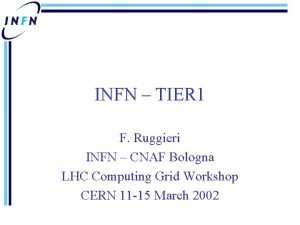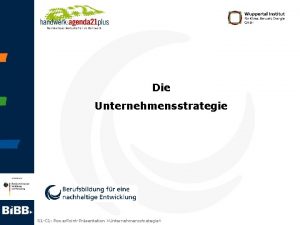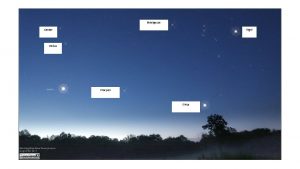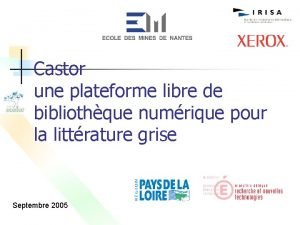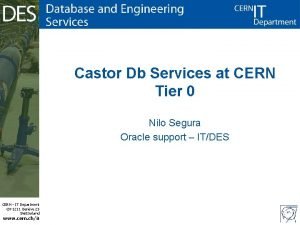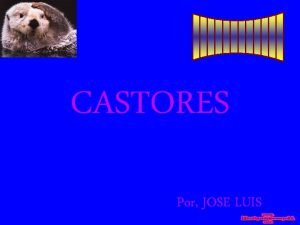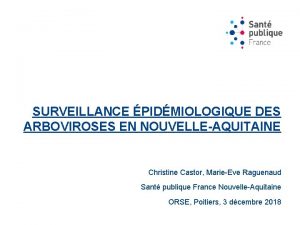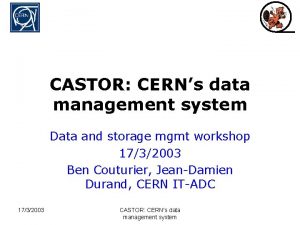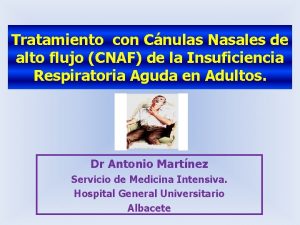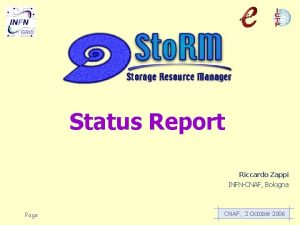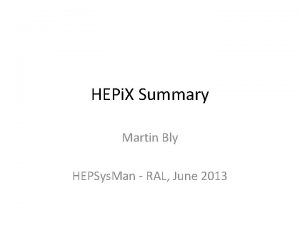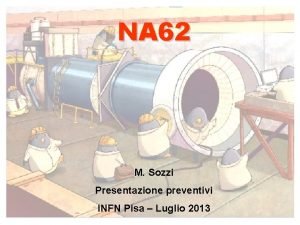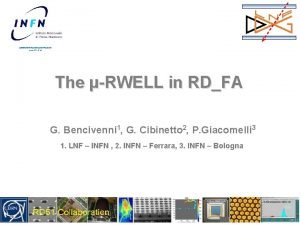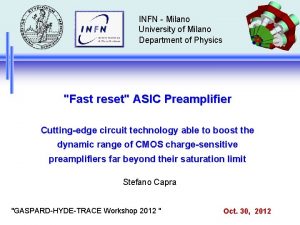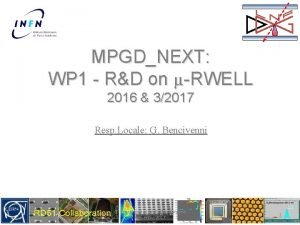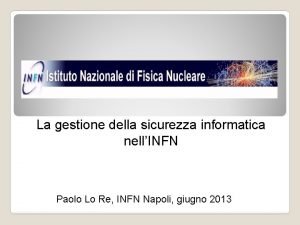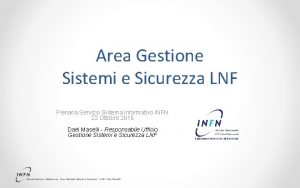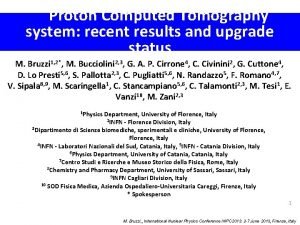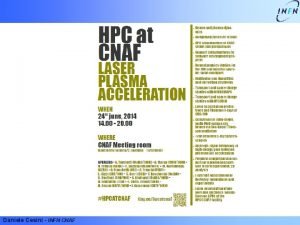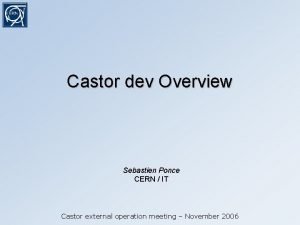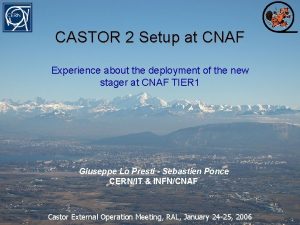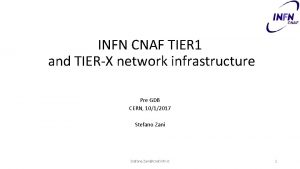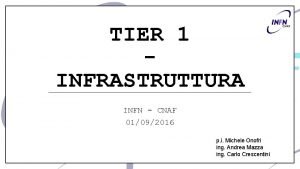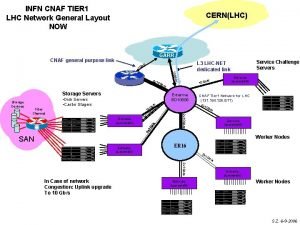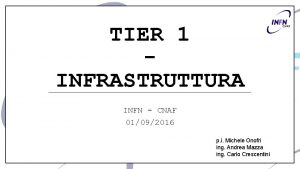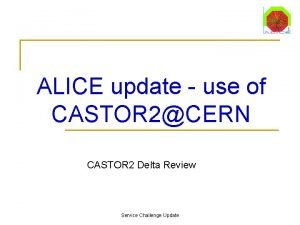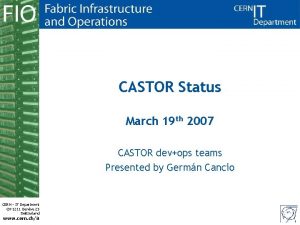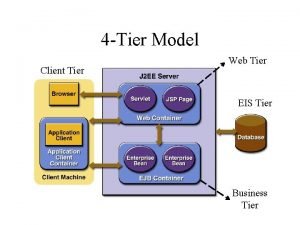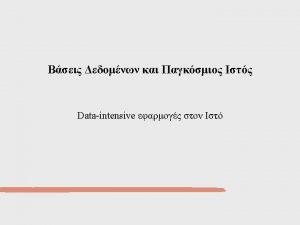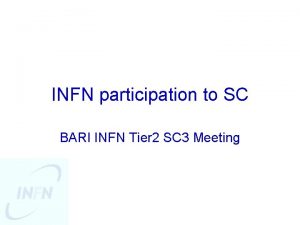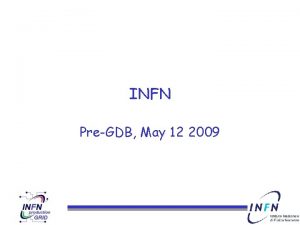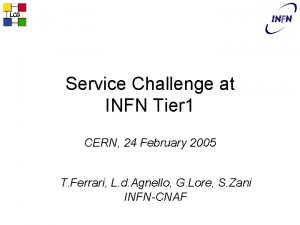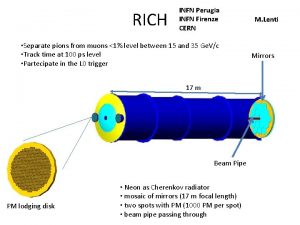INFN CNAF TIER 1 Castor Experience CERN 8



























- Slides: 27

INFN CNAF TIER 1 Castor Experience CERN 8 June 2006 Ricci Pier Paolo pierpaolo. ricci@cnaf. infn. it castor. support@cnaf. infn. it 8 June 2006 CERN

TIER 1 CNAF Experience Hardware and software status of our castor v. 1 and castor v. 2 installations and management tools Experience on castor v. 2 Planning for the migration Considerations Conclusion 8 June 2006 CERN 2

Menpower At present there are 3 people at TIER 1 CNAF working (at administrator level) for our CASTOR installation and front-ends: Ricci Pier Paolo Staff (50% also activity in SAN/NAS HA disk storage management and test, Oracle adm) pierpaolo. ricci@cnaf. infn. it Lore Giuseppe Contract (50% also activity in ALICE exp. as Tier 1 reference, SAN HA disk storage management and test, managing Grid frontend to our resources) giuseppe. lore@cnaf. infn. it Also we have 1 CNAF FTE contract working with the development team at CERN (started March 2005) Lopresti Giuseppe giuseppe. lopresti@cern. ch We are heavily outnumbered. We absolutely need the direct help of Lopresti from Cern in administering, configuring and third level support of our installation (Castor v. 2) 8 June 2006 CERN 3

Hardware & Software At present our CASTOR (1. 7. 1. 5 and 2. 0. 4. 0) system is: 6 LTO-2 DRIVES with 2 Gb/s FC interface (200 GByte) 250 TByte 7 9940 B DRIVES with 1350 9940 B TAPES 2 Gb/s FC interface 1 STK L 5500 SILOS partitioned with 2 form-factor slots About 2000 slots LTO-2 form About 3500 slots 9940 B form 8 June 2006 1300 LTO-2 TAPES (200 GByte)260 TByte Sun Blade v 100 with 2 internal ide disks with software raid-0 running ACSLS 7. 0 (Single Point of Failure) CERN 4

Hardware & Software 13 Tapeservers, standard hardware is 1 U Supermicro 3 GHz 2 GB with 1 Qlogic 2300 F. C. HBA, STK CSC Development Toolkit rpm provided by CERN (with licence agreement with STK) ssi, tpdaemon and rtcpd. All tapeserver have been re-installed with SL CERN 3. 0. 6, "quattorized" and all castor rpms upgraded to version 2. 0. 4. 0 The 13 tapeservers are connected direcly with the drive FC output: DRIVE LTO-2 0, 0, 10, 0 -> tapesrv-0. cr. cnaf. infn. it DRIVE LTO-2 0, 0, 1 -> tapesrv-1. cr. cnaf. infn. it DRIVE LTO-2 0, 0, 10, 2 -> tapesrv-2. cr. cnaf. infn. it DRIVE LTO-2 0, 0, 10, 3 -> tapesrv-3. cr. cnaf. infn. it DRIVE LTO-2 0, 0, 10, 4 -> tapesrv-4. cr. cnaf. infn. it DRIVE LTO-2 0, 0, 10, 5 -> tapesrv-5. cr. cnaf. infn. it DRIVE 9940 B 0, 0, 10, 6 -> tapesrv-6. cr. cnaf. infn. it DRIVE 9940 B 0, 0, 10, 7 -> tapesrv-7. cr. cnaf. infn. it DRIVE 9940 B 0, 0, 10, 8 -> tapesrv-8. cr. cnaf. infn. it DRIVE 9940 B 0, 0, 10, 9 -> tapesrv-9. cr. cnaf. infn. it DRIVE 9940 B 0, 0, 13 -> tapesrv-10. cr. cnaf. infn. it DRIVE 9940 B 0, 0, 14 -> tapesrv-11. cr. cnaf. infn. it DRIVE 9940 B 0, 0, 15 -> tapesrv-12. cr. cnaf. infn. it In 2 years of activity we report that USING THE 9940 B have drastically reduced the error rate (we report only 1 -3% 9940 tape marked RDONLY due to SCSI error) and negligible hang problem 8 June 2006 CERN 5

Hardware & Software castor. cnaf. infn. it Central Machine 1 IBM x 345 2 U machine 2 x 3 GHz Intel Xeon, raid 1 with rendundand power supply O. S. Red Hat A. S. 3. 0 Machine running all central CASTOR 1. 7. 1. 5 services (Nsdaemon, vmgrdaemon, Cupvdaemon, vdqmdaemon, msgdaemon) and the ORACLE client for the central database Installed by source, the central services will be migrated soon castor-4. cnaf. infn. it ORACLE Machine 1 IBM x 345 O. S. Red Hat A. S. 3. 0 Machine running ORACLE DATABASE 9. i rel 2 for the Castor central daemons schemas (vmgr, ns, Cupv) 1 more x 345 machine is in standby and is used for storing all the backup information of the ORACLE db (. exp. dbf) and can be used for replacing the above machines (castor and castor-4) if needed. castor-1. cnaf. infn. it Monitoring Machine 1 DELL 1650 R. H 7. 2 Machine running monitoring CASTOR service (Cmon daemon) NAGIOS central service for monitoring and notification. Also contains the command rtstat e tpstat that are usually runned with the –S option over the tapeserver 8 June 2006 CERN 6

Hardware & Software Stagers with diskserver (v. 1. 7. 1. 5): 1 U Supermicro 3 GHz 2 GB with 1 Qlogic 2300 F. C. HBA accessing our SAN and runnig Cdbdaemon, stgdaemon end rfiod. 1 STAGER for each LHC Experiment and 2 GENERIC STAGERS installed by source. disksrv-1. cnaf. infn. it ATLAS stager with 2 TB direct connected disksrv-2. cnaf. infn. it CMS stager with 3. 2 TB direct connected disksrv-3. cnaf. infn. it LHCB stager with 3. 2 TB direct connected disksrv-4. cnaf. infn. it ALICE stager with 3. 2 TB direct connected disksrv-5. cnaf. infn. it TEST, PAMELA, ARGO stager disksrv-6. cnaf. infn. it stager with 2 TB locally (archive purpose LVD, alice TOF, CDF, VIRGO, AMS, BABAR, and other HEP experiment. . . ) Diskservers: 1 U Supermicro 3 GHz 2 GB with 1 Qlogic 2300 F. C. HBA accessing our SAN and runnig rfiod. 8 June 2006 CERN 7

Hardware & Software Storage Element front-end for CASTOR castorgrid. cr. cnaf. infn. it (DNS alias load balaced over 4 machines for WAN gridftp ) sc. cr. cnaf. infn. it (DNS alias load balaced over 8 machines for SC WAN gridftp) SRM 1 is installed and in production The access to the Castor system is 1) Grid using our SE frontends (from WAN) 2) Rfio using castor rpm and rfio commands installed on our WN and UI (from LAN) Roughly 40% (200 TB / 500 TB) of the total HSM space was effectively used by the experiments so far (3 years of official activity) As TIER 1 storage we offer “pure” disk as primary storage over SAN (preferred by the experiments) (Gridftp, nfs, xrootd, bbftp, GPFS …. ) 8 June 2006 CERN 8

Hardware & Software CASTOR v. 2 (2. 0. 4. 0) servers (all the following servers runs SL CERN 3. 0. 6, "quattorized", castor installation using rpm) castor-6 (1 IBM x 345 2 U server 2 x 3 GHz Intel Xeon, raid 1 system disks, with rendundand power supply) runs central stager services: STAGER + Request Handler + Mig. Hunter + rtcpclientd castorlsf 01 (HP Proliant DL 360 G 4 1 U server 2 x 3 GHz Intel Xeon, raid 1 system disks, with rendundand power supply) runs MASTER LSF server v. 6. 1 (at present we run only a master instance of LSF for Castor v. 2) oracle 01 (HP Proliant HA machine 2 x 3. 6 GHz raid 10 with rendundand power supply) runs the STAGER Database over Oracle 10. 2. 0. 1. 0 8 June 2006 CERN 9

Hardware & Software diskserv-san-13 (Supermicro 1 U 3 GHz no hardware rendundand) runs the services: DLF, DLF database, RMMASTER and EXPERT castor-8 (1 IBM x 346 2 U server 2 x 3. 6 GHz Intel Xeon, raid 1 over 2 system disks and raid 5 over 4 disks with rendundand power supply) runs the new central services version 2. 0. 4 -0 (nsdaemon, msgdaemon, vdqmserver, msgdaemon, Cupvdaemon) The castor-8 machine will be the new central services machine. Some preliminary tests showed that the six castor v. 1 stagers can use this machine without apparent major problems. 8 June 2006 CERN 10

TIER 1 CNAF Storage Overview HSM (400 TB) NAS (20 TB) STK 180 with 100 LTO-1 (10 Tbyte Native) W 2003 Server with LEGATO Networker (Backup) CASTOR HSM servers STK L 5500 robot (5500 slots) 6 IBM LTO-2, 4 STK 9940 B drives Linux SL 3. 0 clients (100 -1000 nodes) NFS RFIO H. A. PROCOM 3600 FC NAS 2 7000 Gbyte NFS-RFIO-Grid. FTP oth. . . SAN 2 (40 TB) 2 Gadzoox Slingshot 4218 18 port FC Switch AXUS BROWIE About 2200 GByte 2 FC interface SAN 1 (450 TB RAW) IBM Fast. T 900 (DS 4500) 3/4 x 50000 GByte 4 FC interfaces Infortrend 4 x 3200 GByte SATA A 16 F-R 1 A 2 -M 1 8 June 2006 PROCOM 3600 FC NAS 3 7000 Gbyte WAN or TIER 1 LAN Diskservers with Qlogic FC HBA 2340 STK Blade. Store About 25000 GByte 4 FC interfaces NAS 1, NAS 4 3 ware IDE SAS 1800+3200 Gbyte Brocade SAN Fabric 24000 64 port FC 2 Silkworm 3900 32 port FC Infortrend 5 x 6400 GByte SATA A 16 F-R 1211 -M 2 + JBOD CERN STK Flex. Line 600 5 x 50000 GByte 4 FC interfaces 11

STK L 5500 2000+3500 CASTOR v. 1 6 drives LTO 2 (20 -30 MB/s) 7 drives 9940 B (25 -30 MB/s) Point to Point FC 2 Gb/s connections 13 tapeserver 1300 LTO 2 (200 GB native) Linux SL 3 1350 9940 B (200 GB native) HBA Qlogic 2300 TOTAL CAPACITY with 200 GB Sun Blade v 100 with 2 internal ide disks with software raid-1 running ACSLS 7. 0 OS Solaris 9. 0 EXPERIMENT 250 TB LTO-2 (400 TB) 260 TB 9940 B (700 TB) Stage (TB) Tape (TB) % rdonly ALICE 13 14(LTO-2) 8% ATLAS 17 48(9940) 8 (LTO-2) 2% 30% CMS 15 28(9940) 0% LHCb 18 43(LTO-2) 10% BABAR (backup) 4 20(LTO-2) 2% VIRGO (backup) 1. 5 5(LTO-2) 10% CDF (backup) 1 9(LTO-2) 5% AMS 3 5(9940) 0 ARGO+other 6 21(9940) 1% Indicates Full rendundancy FC 2 Gb/s connections (dual controller HW and Qlogic SANsurfer Path Failover SW) 8 June 2006 1 CASTOR (CERN)Central Services server RH AS 3. 0 1 ORACLE 9 i rel 2 DB server RH AS 3. 0 WAN or TIER 1 LAN 6 stager with diskserver 15 TB Local staging area SAN 2 CERN Rfio diskservers RH AS 3. 0 staging area (variable) SAN 1 12

Monitoring and Notification 8 June 2006 CERN 13

MONITORING (Cmonitor) Stage Pool Real time Disk to tape streams performance Very useful for tracing real-time bottleneck Support for the future required! 8 June 2006 CERN 14

Castor v. 2 Experience December 2005: First servers installed with the direct help of Lopresti on-site. A single disk-only pool as test purpose January 2006: Problem with the two domains and the migration End of January 2006: Installed the first v. 2 tapeserver during the RAL External Operation Workshop, fixed some stager problem, first real tape migration February-March 2006: Installed new diskserver and experience over different file classes, problem with minor bugs (two domains) some fixes provided April 2006: SC 4 failure due to LSF and nameserver compatibility and other minor bugs. Installation of a new machine (castor-8) with v. 2 central services (nameserver) and upgrade of LSF, fix garbage collector problems May 2006: Re-run of SC 4 over the new nameserver (OK) June 2006: Upgrade of all the tapeserver to latest version. Ready to migrate some of the LHC experiments to Castor v. 2 8 June 2006 CERN 15

Castor v. 2 SC Experience a) b) The castor v. 2 stager and the necessary 2. 0. 4 nameserver on castor-8 has been used in preproduction during the Service Challenge rerun on May (after the problem during the official Service Challenge phase) A relative good disk to disk bandwidth of 170 MByte/s and a disk to tape bandwidth of 70 MByte/s (with 5 dedicated drives) has been granted over a full week period. We write an high quantity of data on tapes (about 6 TByte/day) but we actually didn't test: The access to the data in the staging area from our farming resource (test stress the staging area access) The recalling system from tape with heavy requests of not-staged files in random order (tape stress of the stage-in procedure from tapes) 8 June 2006 CERN 16

Migration Planning (stagers) We have 3 hypothetical choices for migrating the six production stagers (and related staging area) to the castor v. 2 stager Smart Method: CERN could provide a script for directly converting the staging area from castor v. 1 to castor v. 2 renaming the directory and files hierarchy on the diskservers and adding the relative entry in the castor v. 2 stager database. The diskserver are in such a way "converted" directly to castor v. 2. 2) Disk to disk Method: CERN could provide script for copying from the castor v. 1 staging area to the castor v. 2 stager without triggering a migration. We should provide new diskservers for castor v. 2 during this phase with enought disk space for the "staging area" copy 3) Tape Method: The castor v. 1 staging areas are dropped and new empty space is added in the castor v. 2 stager. According to the experiment users usage a stage-in from tape of a large bunch of useful files is triggered to "popolate" the castor v. 2 stager Since it will be very difficult for us to re-read a big number of file on our limited number of drive we cannot use the 3 rd solution. 1) 8 June 2006 CERN 17

Migration Planning (services) The castor. cnaf. infn. it machine (running central services v. 1. 7. 1. 5) will be dismissed A DNS alias "castor. cnaf. infn. it" will be created pointing to the castor-8. cr. cnaf. infn. it server The old castor. cnaf. infn. it machine will be reinstalled as castor-9. cr. cnaf. infn. it as a clone of castor-8 running in addition a vdqm replica All the native-replicable castor central services (nsdaemon, vmgrdaemon and Cupvdaemon) will run on both the machines We will obtain a DNS load balancing and High Avaliability installation of Castor for the central service (ns, vmgr, Cupv and vdqm using master and replica) (msgdaemon? ) 8 June 2006 CERN 18

Standard Diskservers Model 20 Diskservers with dual Qlogic FC HBA 2340 Sun Fire U 20 Z dual Opteron 2. 6 GHZ DDR 400 MHz 4 x 1 GB RAM SCSIU 320 2 x 73 10 K 10 TB each diskserver Brocade Director FC Switch (full licenced) with 64 port (out of 128) central fabric for the other 2 3900 4 x 2 GB redundand connections to the Switch 5 Flexline 600 with 250 TB RAW Disk Space (200 TB) RAID 5 8+1 Performance on single volume not high (45 w 35 r) (but good 300400 MB/s aggregate) Probably parallel I/O needed to optimize performance 8 June 2006 CERN 19

Standard Diskservers Model WAN or TIER 1 LAN GB Eth. connections: rfiod (also nfs, xrootd, GPFS direct gridftp. . . ) 1 2 LUN 0 => /dev/sda LUN 1 => /dev/sdb. . . 2 TB Logical Disk LUN 0 LUN 1. . . 3 4 Generic Diskserver 1 U. 2 Qlogic 2300 HBA Linux CERN SL 3. 0 OS 2 2 Gb FC connections every Diskserver SAN FC SAN ZONED (50 TB Unit with 4 Diskservers) Single server connected in different switches or 24000 blades 2 Gb FC connections A 1 A 2 B 1 B 2 RAID 5 50 TB Disk Unit Dual redundant Controllers (A, B) Internal Mini. Hub (1, 2) 4 Diskservers every ~50 TB 4 "High performance" servers can reach the maximum bandwidth of 200/400 MB/s (peak of the storage subsystem) 8 June 2006 F 1 F 2 FARMS of rack mountable 1 U biprocessors nodes (actually about 1000 nodes for 1300 Kspec. Int 2000) FC Path Failover HA: • Qlogic SANsurfer Application HA: • NFS server, with Red Hat Cluster AS 3. 0 • GPFS with configuration NSD Primary Secondary /dev/sda Primary Diskserver 1; Secondary Diskserver 2 /dev/sdb Primary Diskserver 2; Secondary Diskserver 3 • rfiod diskserver for Castor v. 2 (to be implemented) CERN 20

Diskserver consideration One of the major difference from the TIER 0 model and our TIER 1 is in the diskservers. We have a small number of high performance diskservers with big quantities of disk storage connected (~12 TByte). This will be the model also in the short-term period. A major failure in one diskserver could "cut down" the castor staging area of an essential disk area. We have a SAN infrastructure that could provide everything needed for an High Avaliability System The idea is that we would like to implement some sort of rfiod failover using Redhat Cluster (or equivalent) and registering virtual diskservers IP in the Stager and LSF catalog. We can do all the tests and the work on the cluster service but perheps some customization of Castor v. 2 will be needed. 8 June 2006 CERN 21

General considerations When we start 2 years ago the Castor External Collaboration (with our old Director Federico Ruggeri, PIC and CERN) the idea was that the Castor Development Team should take into account some specific customization needed in Tier 1 sites (The original problem was the LTO-2 compatibility) To improve the Castor Development Team Tier 1 CNAF agreed to provide manpower in terms of 1 FTE at CERN So far, the main activity requested from the Tier 1 CNAF was support in term of current installation and help in upgrading to the Castor v. 2 After many years of production of Castor v. 1 we become able to recover from mostly of the error conditions and contacts the Cern Support only as a "last resource" The situation is different in Castor v. 2. From our point of view the software is more complicated and "centralized" and we lack in skills and tools to investigate and solve problems ourselves. Also the software itself is still in development. . . 8 June 2006 CERN 22

General considerations (2) The Service Challenge 4 is just started and we still have the 4 LHC Experiments over Castor v. 1 (only d-team is mapped on castor v. 2). This is really a problem. SO WHAT WE NEED TO MAKE CASTOR v. 2 WORKING IN PRODUCTION? ("official requests") 1) The stager disk area migration should be concluded. Any solutions other that the "smart" method (diskserver direct conversion) could seriously influence the production and the current SC activity. We definitely ask a customization from CERN Development Team for this migration. 2) The castor central service migration and load balancing/high avaliability activity should be ended. This could be done by us probably with little support from CERN 8 June 2006 CERN 23

General considerations (3) 3) 4) After migrating the production over Castor v. 2 the CERN support system should improve and grant a real-time direct remote support for the Tier 1. Support team will have access to all the Castor, lfs and Oracle servers at Tier 1 to speed up the support process. Due to the high "centralized" and complicated design of Castor v. 2, and the lack of skills at the Cnaf Tier 1 any problem could block the access to the whole Castor installation. If support is given only by e-mail and after many hours or days this could seriously affect the local production or analysis phases and translates in a very poor service. The "direct" support could be done firstly by Lopresti since he can dedicate a fraction of time also to monitor and help administering our installation. But also all the other members of the development team should have the possibility to investigate and solve in real-time the high priority problems at the Tier 1 8 June 2006 CERN 24

General considerations (4) The design of the Castor v. 2 was supposed to overcome the old stager limits in such a way that a single stager instance could provide service for all the LHC experiments. As Tier 1 we don't want to find limits also in the Castor v. 2 design that will force us to have multiple Lsf, stager, and Oracle instances to scale performance and capacity. The idea is that, even when LHC and other “customers” will run at full service, the Tier 1 expected data capacity and performance can be provided by a single LSF, stager and Oracle instance. The Development Team should take into account these considerations when optimizing the whole system evolution. We won't have the manpower and skill to manage a multiple installation of the castor v. 2 services. (one example: it seem that the new Oracle tablespace of the nameserver requires more space for the added ACL records. This translate in bigger datafile and perheps a single instance could not be enought in the next years. Is possible to prevent and optimize? ) 8 June 2006 CERN 25

Conclusion Our experience with Castor v. 2 was overall good but we actually didn't test the heavy access to the staging area or tape recalling (perheps the most critical parts? ) The failure of the official phase of SC due to a LSF known bug suggests that the production installation needs an "expert" eye (at development level) for the administration, debugging and optimization of the system. Also the lack of a user-friendly command interfaces and documentation in general suggests that becoming a new administrator of Castor v. 2 won't be easy (Oracle query), and tracking/solving problem will be almost impossible without having a very good knowledge of the code itself and all the mechanisms involved. 8 June 2006 CERN 26

Conclusion We agree to migrate all the stagers to Castor v. 2 to help CERN with the support and for "standardizing" (quattor, rpms. . . ) installations in the different Tiers. But, as part of the Castor External Collaboration, we ask that the Development Team should take into account all the needed and future CNAF Tier 1 customizations. We ask that the scripts needed to optimize and speed up the migration process are developed by CERN. We ask also that when officially Castor v. 2 at CNAF Tier 1 will be in production a real-time first support will be granted at development level (with a contact in few hours in case of major blocking problems). Also the consideration about the peculiar CNAF diskservers model, the possibility of high avaliability rfiod and the scalability of Castor v. 2 at Tier 1 level should be taken into account (Castor must be designed to work also easily al Tier 1 level!) 8 June 2006 CERN 27
 Tier 1 tier 2 tier 3 vocabulary
Tier 1 tier 2 tier 3 vocabulary Tier 1 words
Tier 1 words Cnaf infn
Cnaf infn Unternehmensstrategien arten
Unternehmensstrategien arten Saponification value significance
Saponification value significance Sirius og castor
Sirius og castor Castor plateforme
Castor plateforme Poésie le dernier sapin mr truchi
Poésie le dernier sapin mr truchi Castor db
Castor db Castor nido
Castor nido Christine castor
Christine castor Castor data management
Castor data management Indirect experience examples
Indirect experience examples Imprinting meaning psychology
Imprinting meaning psychology Early experience vs. later experience
Early experience vs. later experience Max venturi high flow
Max venturi high flow Cnaf 3710 weather minimums
Cnaf 3710 weather minimums Cnaf 2
Cnaf 2 Old man ral
Old man ral Organigramme cnaf
Organigramme cnaf Infn pisa
Infn pisa Www.lnf.infn.it
Www.lnf.infn.it Infn milano
Infn milano Www.lnf.infn.it
Www.lnf.infn.it Paolo lo re
Paolo lo re Sisinfo infn
Sisinfo infn Infn v'y
Infn v'y Infn roma tor vergata
Infn roma tor vergata


